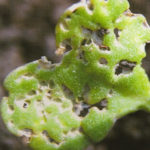
As temperatures warm up, flea beetles are emerging and on the move. Feeding damage is evident in early emerged canola. Peak emergence from overwintering sites occurs once soil temperatures reaches 150 C (60 0 F).
Depending on temperatures, flea beetles can take up to 3 weeks for all adults to emerge. Adults emerge overwinter in shelterbelts, fencerows, leaf litter and initially crawl, hop to feed on winter annuals, crucifers (e.g. peppergrass, volunteer mustard) before moving to canola.
In Ontario we see both striped and crucifer flea beetles damaging canola. Striped flea beetles emerge sooner than crucifer flea beetles, are more tolerant of the neonic seed treatments (e.g. Prosper, Helix) and are more aggressive feeders.
Lumiderm (DuPont) seed treatment that is available on some canola varieties contains a new active insecticide that improves control of flea beetles under moist/wet soil conditions and offers improved control of striped flea beetles. Helix and Prosper seed treatments are neonic insecticides that are water soluble and more susceptible to dilution under saturated soil conditions. Lumiderm is less water soluble, so should preform better across a wide range of soil conditions. Lumiderm comes along with either Prosper or Helix, for broad flea beetles control under moist or dry soil conditions.
Spray Decision Guide
- Expect to see some feeding damage. All insecticide seed treatments are systemic, so flea beetles must take a bite to be controlled. An early spray won’t protect canola from re-infestation. Flea beetles are strong fliers and can quickly re-infest a field.
- Canola stands that are healthy and rapidly growing can tolerate higher flea beetle numbers.
- Control is necessary when 25% of the surface leaf area is damaged. Under cool, windy conditions, check the underside of leaves and the stem for damage.
- Check new growth for feeding. Although seed treatments can provide up to 3-4 weeks control, don’t let your guard down if flea beetles are overtaking new growth. Check newly emerging leaves for damage as damage to the growing point can affect crop development. Cotyledons can withstand higher feeding levels if the new leaves are unaffected, but action may be necessary sooner if new growth is being eaten.
- At temperatures above 15 0 C, monitor stands more frequently.Flea beetles damage can increase rapidly under warm, dry conditions
- Assess the health of the canola stand. Thin stands with 5 plants/sq. ft. or less, uneven or unthrifty stands will require a close watch and quick action to protect the stand. On the other hand a healthy vigorous stand can sustain higher populations and often ‘out-grow’ feeding damage. Continue to monitor up to the 4 leaf stage.
- Watch Field Margins. Early in the season flea beetles migrate into field margins from over-wintering sites in fencerows and woodlots. Pesticide application to field margins may limit invasion if they have not spread throughout the field. As temperatures warm up flea beetles become much more mobile, moving readily throughout fields.
- Application tips. Insecticides provide contact activity so control will be most effective during the warmest, sunniest periods of the day when beetles are most actively feeding. On cool cloudy or windy days, beetles stay closer to the ground feeding on the underside of leaves or stems. It is critical to achieve good product coverage by using an appropriate size nozzle providing medium droplet size and good water volume 38-65 l/ac (10-15 gal/ac). But be careful not to spray to the point of runoff. Nozzle manufacturers have good charts showing the relationship between droplet size and pressure for different nozzle types.
- Resistance Management: If you need to spray more than once try to change to a different insecticide group to reduce the chance of resistance developing.
- Registered products include products listed below. If more than one application is required, rotate between classes of products (see table below).
| Insecticide Group Classification | Product Name |
| Pyrethroid | Decis 5.0, Matador 120 EC, Silencer 120 EC, Ripcord 400, |
| Carbamate | Furadan 480F, Sevin XLR plus |
- Protect Honey Bees.
Avoid applying insecticides if bees are actively feeding. In early spring, honey bees feed on most flowering weeds and in many trees/shrubs that are flowering at this time. Before applying a pesticide, advise local beekeepers so they can move colonies out of the danger area.
Contact the Provincial Apiarist at 1-888-466-2372 extension 6-3595 for a list of the beekeepers in the area or www.ontario.ca/crops and click “Apiculture” for a list of provincial bee inspectors who know the local beekeepers.
Please also refer to the Table 9–9 below: Relative Toxicity of Insecticides to Honeybees (from Pub 812 Field Crop Protection Guide)
| Table 9-9. Relative Toxicity of Insecticides to Honeybees | |
| Trade Name | Active Ingredient |
| Group 1 – Very toxic. Do not apply to flowering crops or weeds. | |
| Concept | imidacloprid + deltamethrin |
| Cygon 480Lagon 480 | dimethoate |
| Furadan 480 F | carbofuran |
| Imidan 50 WP | phosmet |
| Lannate Toss-N-Go | methomyl |
| Lorsban 4EPyrifos 15G
Pyrinex 480 EC |
chlorpyrifos |
| Malathion 500 EC | malathion |
| Ripcord 400 EC | cypermethrin |
| Sevin XLR | carbaryl |
| Group 2 – Apply only during late evening or early morning1 | |
| Decis 5.0 EC | deltamethrin |
| Thiodan 4 ECThionex EC | endosulfan |
| Group 3 – Low toxicity | |
| Lumiderm | cyantraniliprole |
| 1 Unusually low temperatures at time of application may cause insecticides to remain toxic up to 20 times longer than during warm weather. High temperatures in the early morning or late evening may extend active foraging by bees. | |